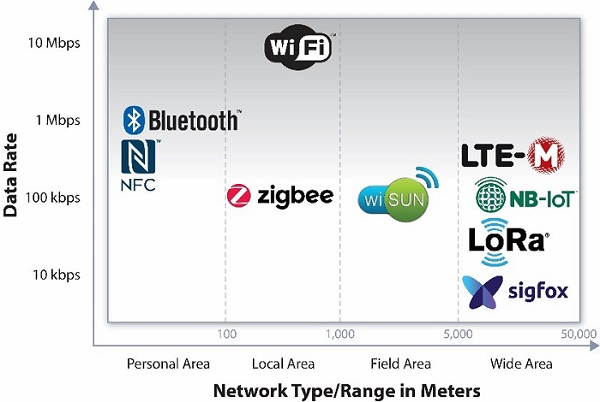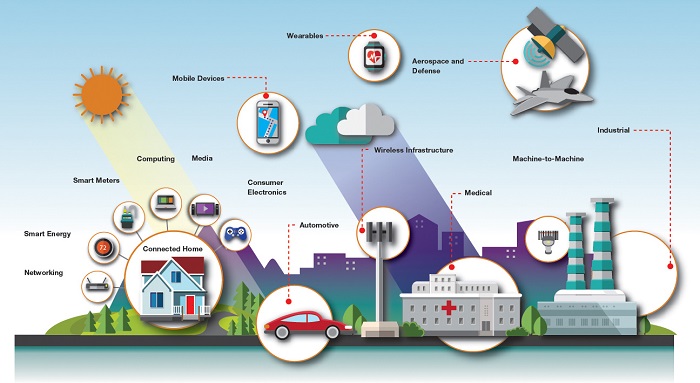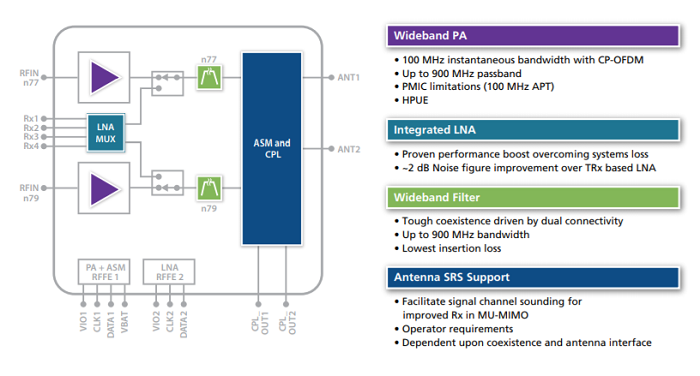
everything RF Interviewed John O’Neill, vice president of marketing for Skyworks Solutions. He joined the company in 2010 and leads the company’s broad markets business diversification efforts. Prior to joining Skyworks, O’Neill served as vice president of marketing and sales for Symwave, Inc., a semiconductor company and pioneering supplier of USB 3.0 system-on-chip and software solutions.
Throughout his career, he has also held various management positions at ClariPhy Communications, Broadcom Corporation, GlobeSpan Semiconductor, and VTC Inc. O’Neill received a bachelor’s of science degree in electrical engineering from the University of Illinois at Urbana-Champaign.
Q. How is Skyworks addressing product development for IoT? Are you developing products for each of the standards (LoRa, Sigfox, ZigBee, NB-IoT, LTE-CAT M1 etc.)? Or are you developing for some specific standards?
Skyworks has developed a broad portfolio of products and intellectual property for IoT applications that cover a wide range of wireless protocols. Our solutions address not only those mentioned but many others spanning all categories of cellular, Wi-Fi® and Bluetooth®. Our advanced semiconductors are baseband agnostic, offer unmatched power efficiency and range extension, and often solve coexistence issues between multiple wireless standards. Further, our highly integrated solutions simplify the design process for our customers, reducing their time to market. Skyworks is also actively involved in 3GPP, 5GAA and WFA/IEEE 802.11 (Wi-Fi) standards bodies, helping define protocols for next-generation products.
Q. How do you expect IoT to play out from a technology/standards point of view? Do you see (or are you seeing) one or two of the standards being adopted globally or will there be a set of different technologies/standards for different applications and in different regions?
IoT will continue to be a fragmented market with a diverse set of applications and use cases employing a broad spectrum of protocols in both licensed and unlicensed bands. Whether indoor or outdoor, fixed or mobile, low or high data rate, there is typically more than just one technology that can address a specific need.
WiFi®, Zigbee®, and Bluetooth® have been the most popular wireless standards for IoT devices to date given their prevalence and consumer awareness. Newcomers such as LoRaWAN® and WiSUN have also emerged more recently, offering certain advantages such as longer range and greater scalability. While each of these protocols offers different features and benefits, there are tradeoffs to be considered when addressing power consumption, coverage ranges and cost. With this in mind, we work very closely with our global customers to determine their specific needs based on the protocol or standard they choose to employ.

Q. Can you tell us about your portfolio of products for IoT and their area of application?
Skyworks’ IoT portfolio offers many choices for engineers and developers working on a variety of products and systems. Our solutions range from discrete single function devices to fully integrated front-end modules (FEMs) containing multiple functions in a single package, as well as full turnkey radios plus RF system-in-packages (SiPs). Applications are endless and include automotive connectivity, connected home, smart watches, trackers and other wearables, medical devices, industrial automation, smart cities, audio assistants, wireless audio, gaming and more.

Q. What are some key technological requirements for IoT products from an RF front-end point of view?
From an RF front-end point of view, hitting the critical transmit output power, linearity, receive sensitivity, signal isolation, and system level power efficiency are just some of the most important technical requirements. Each end product’s RF implementation will be slightly different, so it is critical that Skyworks has a portfolio of solutions to address the spectrum of possible requirements.
As a complement to the open market technologies available, Skyworks also offers our vertically integrated, advanced manufacturing capabilities including proprietary RF-optimized wafer fabrication and leading-edge packaging, assembly and test facilities. By leveraging both in-house and open market technologies, Skyworks is able to provide solutions across a broader range of transmit powers, frequencies, levels of integration and power dissipation to meet the end-product requirements.
As it relates specifically to cellular-based IoT (known as “Mobile IoT”), Skyworks has taken the lead to certify our SiP solutions with global cellular network providers. This pre-certification accelerates our customers’ product development and enables them to launch with confidence knowing that the cellular connectivity portion of their product is pre-certified for use on the targeted cellular service provider network.
Q. How is Skyworks addressing product development for 5G?
With decades of experience developing innovative solutions over successive technology generations and across frequencies from DC to GHz, we are capitalizing on our deep systems knowledge, strategic partnerships and formidable investments to accelerate the deployment of 5G. Our leadership position is strengthened by an IP library of over 3,000 patents worldwide. Skyworks has already launched 5G products for cellular infrastructure, mobile, and IoT markets and will continue to expand our portfolio in accordance with demand for 5G solutions, spanning sub-6 GHz to millimeter wave bands.
Q. In your view, what will the transition to 5G from LTE look like?
5G is moving toward consumer reality at a fast pace. With that in mind, mobile operators are implementing near-term, tactical efforts to ensure that 5G demonstration hardware is available today. Release 15 of 3GPP marked the commercial beginning of 5G and we expect this framework to underpin commercial 5G networks being deployed in 2019 and beyond, even though additional network configurations have extended completion of the standard by approximately six months. The changes that caused the delay were incorporated to ensure delivery of all NR architecture options and the finalization of non-standalone and standalone options. The updates will also include further development of the standalone 5G NR specifications as well as refinements to some of the earlier work.
Q. Can you tell us more about the Sky5 Platform?

Sky5™ is our unifying platform for all our 5G solutions. This suite of highly flexible and customizable system solutions provides the performance, footprint and power efficiency that our customers demand. The family includes highly integrated, high performance transmit/receive front-end solutions, as well as diversity receive (DRx) modules. Specifically designed for new spectrum in the sub-6 GHz range, these products offer a MIPI® interface, are baseband agnostic and comply with 3GPP standards.
Q. What is your view on Sub-6GHz vs mm-Wave bands for 5G?
Driven by mobile operators, there is already strong interest to consider the use of available spectrum for 5G including existing licensed frequency bands and unlicensed bands below 6 GHz. With sub-6 GHz solutions available and relatively mature, these 5G implementations are aggressively moving forward in both the wireless infrastructure and handset markets. MmWave is an important part of the long term 5G equation and will be an incremental positive catalyst for the entire wireless industry. We can expect mmWave 5G-based products in multiple form factors including handsets that will likely initially emerge in late 2019. Many other end products will also benefit from the very high data rates and low latency that mmWave 5G offers. General widespread adoption is likely and limited only by the maturity and commercial competitiveness of the solutions relative to alternatives.
Q. What are some key technological requirements for 5G products from an RF Front-end point of view?
There are many new 5G radio challenges for RF designers and the RF front-end community at large. New bands for sub-6 GHz will extend the LTE frequencies from 3 GHz up to 6 GHz in the device. This increase in frequency will push improvements in the radio front-end as the industry tries to maintain current performance while operating at a higher frequency.
Below is a short list of some challenges/requirements for commercial 5G products.
- Antenna multiplexing and tuning, as well as in-device coexistence with 5 GHz Wi-Fi
- Much larger relative percent bandwidths than existing LTE bands
- Envelope tracking (ET) technologies beyond 60 MHz bandwidth
- Sophisticated packaging capable of handling mmWave transmit/receive arrays customized for the end use application. For example, handset versus M-MIMO (multiple-input, multiple-output).
- Power amplifier and overall system level power efficiency as the number of RF streams, frequency bands, and concurrent radio operation increases
Elements of Sub-6 GHz 5G NR Transmit/Receive Module

Q. Is Skyworks developing wireless infrastructure products for 5G as well? Can you tell us more about these products?
Yes. In fact, Skyworks is shipping into 5G small cell and massive MIMO solutions that significantly enhance network efficiency, delivering higher capacity with greater coverage. Small cells are low-power, easy-to-implement radio access points that can operate in both licensed and unlicensed spectrums with a typical range up to several hundred meters. Mobile operators are utilizing a scalable grid of small cells to facilitate network densification, as well as powerful, high-speed connectivity in support of data-intensive and quickly emerging 5G applications.
Skyworks’ portfolio creates viable new options for cellular and wireless providers to cost-effectively address mounting system requirements. Our complete 5G base station portfolio encompasses small cell power amplifiers, drivers, circulators, high-performance low noise amplifiers, high-power, high-isolation switches, and fully integrated FEMs.
Q. When do you see 5G becoming a reality?
Activity levels have been high for the last several years in preparation for this transition across the carrier, handset, automotive and industrial segments. Some commercial wireless infrastructure shipments began in 2018 and we should see 5G-capable hardware and services begin to be available in 2019.